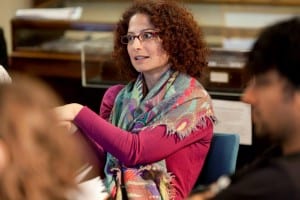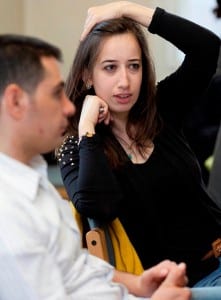Exchanging Knowledge through the Cultural Heritage Fellowship programme
By Edmund Connolly, on 15 October 2012
guest blogger: Tonya Nelson (Petrie Museum Manager)
This year UCL Museums and Public Engagement entered into an exciting partnership with the British Council to develop and deliver a Fellowship programme for museum professionals from the Middle East and North Africa on the topic of community engagement. While in the UK museums are increasingly creating platforms for their communities to advise and consult on the use of collections, create exhibitions and host their own programmes in museum spaces, little of this type of participation occurs in museums in the Middle East or North Africa. Eight Fellows coming from Egypt, Tunisia, Jordan, Algeria, Palestine, and Lebanon were selected for the programme and attended an intensive 2 week training programme in the UK. However, the idea behind the Fellowship programme is not simply to teach the Fellows about community engagement practices in the UK. The Fellowship also seeks to share knowledge and ideas. The hope is that the UK museums supporting the Fellowship will learn about the practices of museums in other countries, build relationships with museum practitioners and institutions abroad and develop a better understanding of how they might serve Middle East/North African communities living in their communities. To that end, I will write a series of blogs this year profiling the Fellows and the innovative work that they are doing in their home institutions. In this blog, I will profile the work of Fellows Carla Mardini from Lebanon and Tamara Musha’sha’ from Palestine.
Carla Mardini holds a Masters Degree in Museology from Reinwalt Academy where she focused on city history museums. She was vice-president of the Association “Beirut Memories Museum and is currently a member of the scientific committee charged with developing the Beit Beirut Museum. Beit Beirut is an innovative project that will convert the Yellow House – a neo-style Ottoman building – into a museum and cultural space. What is important about the Yellow House is that it is located on the ‘Green Line,’ the area that demarcated the east and west Beirut during the Lebanese Civil War (1975-1990). While originally built as apartments for middle class families, during the war it became a control point and sniper base for the surrounding area called the Sedeco Crossroads. The project aims to restore the building, which is badly deteriorating, but preserve traces of the building’s history and role in the war. Thus, sniper holes will remain in the building as part of a museum that will trace the history of the city of Beirut. But the facility will also be a contemporary cultural centre that will include temporary exhibitions, educational workshops, a media library, auditorium for debates and lectures and restaurants and cafes. The project has an amazing website that shows the building in its current state and future plans the building works: http://www.beitbeirut.org/english/index.html. As part of her Fellowship, Carla will be looking into audience research and consultation techniques that will ensure that Beit Beirut serves the needs of the local community.
Tamara Musha’sha’ is the Project Coordinator at the Birzeit University Museum in Ramallah. She holds a MA degree in Democracy and Human Rights and a BA degree in Business Administration. She has worked in various roles at Birzeit University Museum since 2006. This Ethnographic and Art Museum has a renowned collection of Palestinian costumes but is also a pioneering art space that promotes visual arts in the Palestinian community through exhibitions, workshops and education sessions. It has recently completed an exhibition titled, Framed/Unframed: The Changing Representations of Women in Palestinian Art Practice which featured works by artists such as Suleiman Mansour and Mona Hatoum. It is also pioneering in the use of 3D technologies to curate exhibitions. A programme, titled 3DVM, invites young curators to design and install their online virtual exhibitions in a 3D environment. Technical and theoretical assistance is provided to help curators create the exhibition context, object images and application functionality. The project falls within the museum’s mission to develop innovative training tools in the field of visual art studies. You can see it for yourself at http://virtualgallery.birzeit.edu/community_artists_residency.
Both Carla and Tamara are working in pioneering museum environments. It will be interesting to see how the Beit Beirut project balances preservation, restoration and new building work in a way that reflects both the brutal history of Beirut’s civil war and its vibrant cultural landscape. More relevant to my work at the Petrie Museum, the 3D virtual space created by Birzeit University Museum provides a blueprint for the UCL 3D imaging programme. We are currently seeking to create engagement tools using 3D digital replicas of Petrie objects and have prototyped an application called iCurator, which is a virtual 3D museum space that can be populated with museum display cases and objects. I look forward to the possibility of building a research relationship in this area with Tamara and the team at Birzeit University Museum.
One Response to “Exchanging Knowledge through the Cultural Heritage Fellowship programme”
- 1
 Close
Close





[…] [1] Our other Fellows’ blogs are here, here and here […]